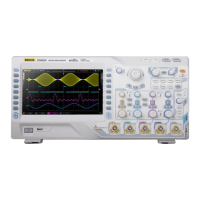
Do you have a question about the Rigol DS4024 and is the answer not in the manual?
| Bandwidth | 200 MHz |
|---|---|
| Channels | 4 |
| Input Coupling | AC, DC, GND |
| Sample Rate | 2 GSa/s |
| Memory Depth | 140 Mpts |
| Vertical Resolution | 8 bits |
| Display | 10.1 inch TFT LCD |
| Trigger Modes | Edge, Pulse, Slope, Video, Pattern |
| Trigger Types | Edge, Pulse, Video, Slope, Pattern, Alternate |
| Interface | USB, LAN |
| Power Supply | 100-240 VAC, 45-440 Hz |
Provides a summary of safety precautions to avoid personal injury or damage to the instrument.
Covers removing the protective cover and adjusting supporting legs for oscilloscope setup.
Details connecting to power supply and performing power-on inspection and self-test.
Introduces probe types and guides connecting passive, active, logic, and Tek probes.
Explains function inspection and compensation procedures for passive probes for accurate measurements.
Explains how to adjust the vertical scale (V/div) and position of waveforms using dedicated knobs.
Guides adjusting the horizontal time base (s/div) and position using scale and position knobs.
Explains selecting trigger sources and adjusting trigger level/threshold for stable waveform capture.
Details the Auto, Normal, and Single trigger modes and their applications.
Provides detailed explanations for various trigger types, including their conditions and settings.
Explains performing various math operations on waveforms, including basic arithmetic, FFT, filters, logic, and advanced expressions.
Guides using auto measurement for 29 parameters and the one-key measurement function for quick analysis.
Details using cursors in Manual, Track, Auto, and X-Y modes to measure waveform values and differences.
Explains protocol decoding for Parallel, RS232/UART, I2C, SPI, CAN, and FlexRay buses.
Guides enabling Pass/Fail test, specifying source channel, and defining test masks using screen or cursor regions.
Details recording waveforms using 'Record' mode (fixed interval) and 'Open' mode (real-time).
Guides playing back recorded waveforms in manual or auto modes, including playback parameters.
Explains analyzing recorded waveforms using trace (template) or pass/fail test mask analysis.
Guides saving and recalling oscilloscope settings, waveforms, and mask files to internal memory.
Details saving and recalling files to/from external USB storage devices.
Guides configuring LAN, USB, and GPIB interfaces for communication with PC or printers.
Details connecting via USB, installing drivers, and searching for device resources with Ultra Sigma.
Guides connecting via LAN, configuring network parameters, and searching for device resources.
Explains GPIB connection using a USB-GPIB converter, installing drivers, and setting GPIB address.